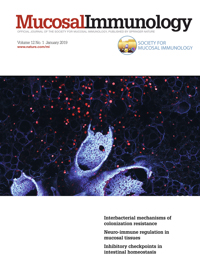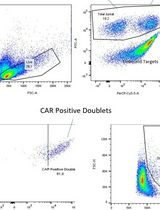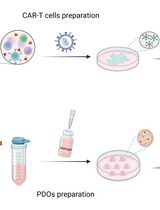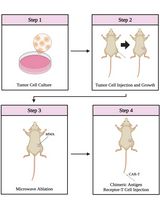- EN - English
- CN - 中文
Evaluation of Mucosal and Systemic Vaccine Responses by Cyclic di-GMP (CDG)-adjuvanted Protein Subunit Vaccines
环二鸟苷单磷酸佐剂蛋白亚单位疫苗引起的粘膜和全身疫苗反应的评估
发布: 2019年04月20日第9卷第8期 DOI: 10.21769/BioProtoc.3217 浏览次数: 5224
评审: Alak MannaVarun KesherwaniWathsala Wijayalath
Abstract
Intranasal administration of vaccine adjuvants directly deliver therapeutic agents to the lungs to induce potent lung mucosal immune responses. Cyclic di-GMP (CDG) is a promising mucosal vaccine adjuvant candidate capable of inducing protective immunity. This protocol describes an in vivo approach to induce and detect mucosal (lung) and systemic (blood and spleen) vaccine adjuvant responses of CDG. This protocol also includes the methods to detect both humoral and cellular immune responses of CDG adjuvant. Last, this protocol can be used to study other cyclic dinucleotides as mucosal vaccine adjuvants.
Keywords: Cyclic dinucleotides (环二核苷酸)Background
Cyclic diguanylate monophosphate (CDG) is part of a new class of vaccine adjuvants called cyclic dinucleotides currently being used in clinical trials for the treatment of cancer and infectious diseases. In vitro and in vivo administration of CDG can induce strong immune responses by engaging the STING pathway to induce production of type I interferon and TNFα (McWhirter et al., 2009; Blaauboer et al., 2014). As a potential mucosal vaccine adjuvant, CDG is well known to induce protective immunity against bacterial pathogens by producing strong antibody and Th1/Th2/Th17 responses in the lung (Ebensen et al., 2007; Yan et al., 2009; Madhun et al., 2011). Mechanistically, this mucosal adjuvant acts through the lung resident dendritic cells (Blaauboer et al., 2014; Mansouri et al., 2019). To date, the cellular and molecular mechanisms of CDG have been mainly characterized by In vitro experiments with murine and human cultured cells. In vitro studies often use transfection reagents to administer CDG into cells. As CDG has two phosphate groups preventing it from directly passing through the cell membrane, the method of transfection may be artificial. Interestingly, CDG was found to be taken up by cells via pinocytosis in vivo (Blaauboer et al., 2015). This protocol describes a more physiological relevant approach to studying the adjuvant effect of CDG in vivo through intranasal immunization.
Materials and Reagents
- BD Instyle Autoguard BC Shielded IV Catheter (BD, catalog number: 381423)
- 1.5 ml Eppendorf tubes (USA Scientific, catalog number: 1615-5510)
- Serum Collection Micro Tube 1.1 ml Z-Gel (Sarstedt, catalog number: 41.1500.005)
- ELISA Assay Plate (Corning, catalog number: 3690)
- 70 µm mesh (Fisher Scientific, catalog number: 22363548)
- 96-well round bottom culture plate (Corning, catalog number: 3799)
- Styrofoam board (we use the tops of ice boxes–there is no catalog number)
- BD PrecisionGlideTM Needle 25 G x 5/8 (BD, catalog number: 305122)
- 1 ml Syringes (BD, catalog number: 309597)
- 50 ml tubes (Corning, catalog number: 430828)
- Mice C57BL/6 male and female (age 8-16 weeks, males, and females)
- PspA (family 1, clade 2) (BEI Resources, catalog number: NR-33178)
- Anti-mouse IgG-HRP (Southern Biotech, catalog number: 1030-05)
- Anti-mouse IgG1-HRP (Southern Biotech, catalog number: 1070-05)
- Anti-mouse IgG2C-HRP (Southern Biotech, catalog number: 1079-05)
- Anti-mouse IgA-HRP (Southern Biotech, catalog number: 1040-05)
- H1N1 influenza A nucleoprotein (Sino Biological, catalog number: 11675-v08B)
- CDG (Invivogen, catalog number: vac-cdg)
- Ovalbumin EndoFitTM (InvivoGen, catalog number: vac-pova)
- Endotoxin-free physiological water (Fisher Scientific, catalog number: BP2470-1)
- Endotoxin-free PBS (Enzo, catalog number: ALX-505-007-L010)
- Isoflurane (Patterson Veterinary, catalog number: NDC 14043-70405)
- 10x PBS (Fisher Scientific, catalog number: BP399-1)
- 70% Ethanol
- Tween® 20 (Fisher Scientific, catalog number: BP337-100)
- ELISA Assay Diluent (Invitrogen, catalog number: 00-4202-43)
- ELISA Coating Buffer (Invitrogen, catalog number: 50-112-8923)
- 1x TMB Solution (Invitrogen, catalog number: 00-4201-56)
- ELISA Stop Solution (Invitrogen, catalog number: SS04)
- RPMI (Invitrogen, catalog number:11875-093)
- DMEM (Invitrogen, catalog number: 11965118)
- Fetal bovine serum (ATLANTA Biological, catalog number: S11150H)
- ACK Lysis buffer (Invitrogen, catalog number: A10492-01)
- 100 mM sodium pyruvate (Gibco, catalog number: 11360-070)
- 1 M HEPES (Gibco, catalog number:15630-80)
- 2-Mercaptoethanol (Sigma, catalog number: M6250-10ML)
- 100x Pen/Strep (Gibco, catalog number:15140-122)
- DNaseI (Roche, catalog number: 10104159001)
- Liberase TM (Roche, catalog number: 05 401 127 001)
- eBiosciencesTM Ready-Set-Go IFNγ, IL-17A, IL-5 and IL-13 ELISA kits (Fishersci, catalog numbers: 50-173-19, 50-112-8965, 50-172-08, 50-172-61)
- Lung digestion buffer (see Recipes)
- 10% Culture Media (see Recipes)
- ELISA washing buffer (see Recipes)
Equipment
- E-Z Anesthesia system (Euthanex Corp)
- Flowmeter (comes with E-Z Anesthesia)
- Vaporizer (comes with E-Z Anesthesia)
- Fisher Scientific Digital Vortex Mixer (Fisher Scientific, catalog number: 02-215-370)
- Forceps (not necessary, any dissecting forceps)
- Scissors (not necessary, any dissecting scissors)
- Thermo Scientific Revco Rel450A Refrigerator (Thermo Scientific, catalog number: DISCONTINUED)
- -20 °C freezer (VWR, catalog number: 10819-408)
- -80 °C freezer (Thermo Scientific, catalog number: RLE30086A)
- xMarkTM Microplate Absorbance Spectrophotometer (BIORAD, catalog number: 168-1150)
- Heracell 150i CO2 incubator (Thermo Fisher, catalog number: 50116047)
Procedure
文章信息
版权信息
© 2019 The Authors; exclusive licensee Bio-protocol LLC.
如何引用
Mansouri, S. and Jin, L. (2019). Evaluation of Mucosal and Systemic Vaccine Responses by Cyclic di-GMP (CDG)-adjuvanted Protein Subunit Vaccines. Bio-protocol 9(8): e3217. DOI: 10.21769/BioProtoc.3217.
分类
免疫学 > 粘膜免疫学 > 疫苗佐剂
癌症生物学 > 肿瘤免疫学 > 癌症治疗
您对这篇实验方法有问题吗?
在此处发布您的问题,我们将邀请本文作者来回答。同时,我们会将您的问题发布到Bio-protocol Exchange,以便寻求社区成员的帮助。
Share
Bluesky
X
Copy link













